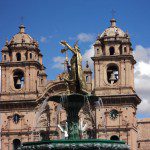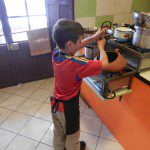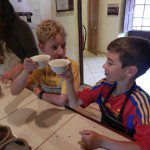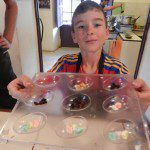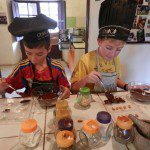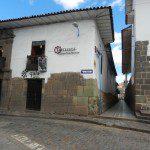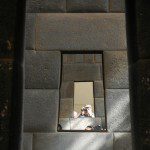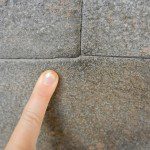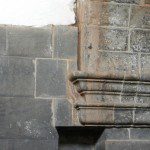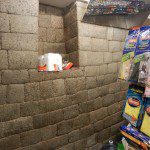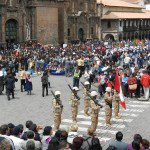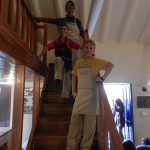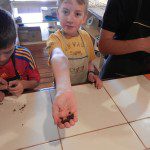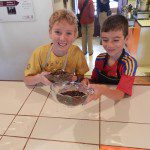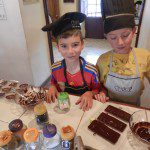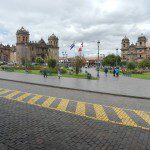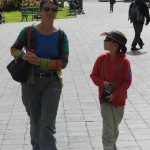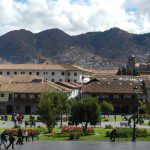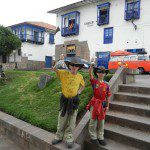Schoolwork au chocolat

“Oh no, you can’t be serious!”, “That’s just not fair” came the chorus of complaint when I explained that after finishing their formal schoolwork of maths and writing we were off to a museum for a two-hour educational course.
“What’s it going to be on?” asked Callum in a resigned voice.
“Something very appropriate to where we are. Something they did here traditionally.” I replied
“Human sacrifice?” asked Declan hopefully “I can practice on Callum!”

We went in to the centre of Cusco, the Plaza de Armes and were immediately taken with this grand square surrounded on two sides by churches and on the others by stylish arcaded buildings. There was some sort of parade starting up as we arrived with lots of marching groups from soldiers to tiny children in fancy dress. It was all very enthusiastic and uplifting although we still have no idea what it was all about.
We strolled a couple of blocks behind the plaza with the boys not exactly dragging but not exactly evidencing overwhelming enthusiasm either. That was until they spotted the sign for the Museo Choco – the Chocolate Museum. Suddenly schoolwork was looking better.

The Museo Choco has only been open a few months and is a great little place. There’s an interesting little display on the history and making of chocolate, from which we learnt a great deal, but the main event is a chocolate-making course. During the course of two hours we roasted our own cocoa beans, shelled and winnowed them, and crushed them. We made tea from the husks and hot chocolate – both Spanish and Mayan – from the ground up chocolate. We then made actual chocolate from the pure, beautiful ingredients.

Although it was the Mayans who domesticated chocolate, the Incas did drink it and it is farmed near Cusco. The variety of cocoa farmed near Cusco is especially fine and accounts for only about one percent of the world’s production. Most commercial chocolate comes from hybrid plants which have much larger seed pods and are more bitter in taste. The chocolate we made today did taste great, but I think it was making it from scratch ourselves that added a lot to the flavour.
We also found a nice connection with our earlier travels in that the first shipments of cocoa looted from Peru were sent back to Seville where they would have been stored in the Torre del Orro just around the corner from where we stayed.

After lunch we visited the monastery of Santo Domingo. This Dominican monastery is particularly significant because it is a singular example of how the Spanish and the Catholic Church took over the ‘New World’. The Monastery is built right on top of Qorikancha (the Courtyard of Gold) the most important religious site in the Incan Empire. What makes the monastery particularly interesting today is that you can see the wonderful Incan stonework with later, much poorer, colonial additions placed on top. The Incan stonework is just amazing, the seams are like hairlines and all without any mortar. The Incan’s used a method much like a dentist getting a filling to feel right: tap the two sides together and then shave off what touches, repeat until the fit is perfect. The lines where more rough stonework using mortar join on are amazingly clear.

The wonderful temple walls would not have been visible in the Incan’s day. They were covered in gold and silver which went to pay the astonishing ransom demanded by Pizarro for Atahuallpa’s release. The centrepiece of the complex though was an enormous gold disc used to reflect the sun into the inner reaches of the temple. The disc was not handed over and was never found, and many people think is still hidden somewhere.
Although the temple walls are the best examples of Incan stonework they are not the only examples in Cusco. Much of the old city is built on Incan foundations. Even the little supermarket we bought some supplies in had an Incan wall – with some plastic trays stacked in a ceremonial niche.
Sitting in the Monastery’s garden, which once displayed golden replicas of Incan foods, we had a wonderfully wide-ranging discussion about colonisation, religion, American Presidential elections and stem-cell research. Sometimes there seem to be distinct benefits to schoolwork on the road.
So all-in-all an educational day for us although, in what I’m sure is just an oversight, my quick search of the NSW Department of Education curriculum fails to find mention of chocolate making anywhere.
